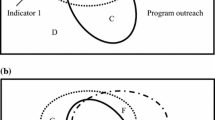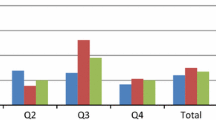Abstract
We propose an empirical method for improving food assistance scoring and targeting, which minimizes under-coverage and leakage of food and cash assistance programs. The empirical strategy relies on a joint econometric estimation of food insecurity and economic vulnerability indicators at the household level, using data-driven instead of predetermined quantiles. We applied the method to recent micro data on Syrian refugees in Lebanon, to explore how regional and community-based aggregates can improve the targeting effectiveness of aid programs, notably food aid by the World Food Program in Lebanon. Our results confirm that using regional aggregates are useful for augmenting the Balanced Poverty Accuracy Criterion, and our method performs much better than the current policy in terms of targeting effectiveness and accuracy for economically vulnerable households.
Similar content being viewed by others
Notes
The Minimum Expenditure Basket (MEB) is an index that is used to construct poverty lines in various contexts, including for refugee populations. It is emerging as a primary index to develop a cost and market based expression of minimum needs of refugees in any given country. It broadly follows the notion of a “cost of basic needs approach” as outlined in the World Bank Poverty Manual from 2005.
WFP VAM Targeting verification criteria document
References
Agostini, C. A., & Brown, P. H. (2011). Cash transfers and poverty reduction in Chile. Journal of Regional Science, 51, 604–625.
Amarasinghe, U., Samad, M., & Anputhas, M. (2005). Spatial clustering of rural poverty and food insecurity in Sri Lanka. Food Policy, 30, 493–509.
Barrett, C. B. (2002). Food security and food assistance programs. In Handbook of Agricultural Economics, vol. 2, Chapter 40. Dordrecht: Elsevier Science.
Benfield, W. A. (2007). Optimum targeting: The Jamaica food stamp programme. Social and Economic Studies, 56(4), 121–164.
Besley, T., & Kanbur, R. (1988). Food subsidies and poverty alleviation. Economic Journal, 98, 701–719.
Besley, T., & Kanbur, R. (1993). The principles of targeting. In M. Lipton & J. Van der Gaag (Eds.), Including the Poor. Washington DC: World Bank.
Borjas, G. J. (2004). Food insecurity and public assistance. Journal of Public Economics, 88, 1421–1443.
Chung, K., Haddad, L., Ramakrishna, J., & Riely, F. (1997). Identifying the food insecure: The application of mixed-method approaches in India. Washington DC: International Food Policy Research Institute.
Clay, D. C., Molla, D., & Habtewold, D. (1999). Food aid targeting in Ethiopia: A study of who needs it and who gets it. Food Policy, 24(4), 391–409.
Dercon, S. (2006). Vulnerability: A micro perspective. In Securing Development in an Unstable World (François bourguignon, Boris Pleskovic and Jacques van der Gaag, eds.), pp. 117-146. Proceedings of the annual World Bank conference on development economics—Europe 2006.
Dilley, M., & Boudreau, T. E. (2001). Coming to terms with vulnerability: A critique of the food security definition. Food Policy, 26(3), 229–247.
Drummond, J., R. Khoury, S. Bailey, N. Crawford, L. Fan, R. Milhem, and S. A. Zyck (2015). An Evaluation of WFP's Regional Response to the Syrian Crisis, 2011-2014. Evaluation report OEV/2014/19, Overseas Development Institute for the WFP Office of Evaluation. Rome: United Nations.
Elbers, C., Fujii, T., Lanjouw, T., Özler, B., & Yin, W. (2007). Poverty alleviation through geographic targeting: How much does disaggregation help? Journal of Development Economics, 83(1), 198–213.
Glewwe, P. (1992). Targeting assistance to the poor: Efficient allocation of transfers when household income is not observed. Journal of Development Economics, 38(2), 297–321.
Haddad, L., Hoddinott, J., & Alderman, H. (Eds.). (1997). Intrahousehold resource allocation in developing countries: Models, methods and policy. Baltimore: Johns Hopkins University Press.
Hyman, G., Larrea, C., & Farrow, A. (2005). Methods, results and policy implications of poverty and food security mapping assessments. Food Policy, 30, 453–460.
IRIS Center. (2005). Note on assessment and improvement of tool accuracy. http://www.povertytools.org/training_documents/Introduction%20 to%20PA/Accuracy_Note.Pdf.
Jaynes, T. S., Strauss, H., & Yamano, T. (2001). Giving to the poor? Targeting of food aid in rural Ethiopia. World Development, 29(5), 887–910.
Jones, A. D., Ngure, F. M., Pelto, G., & Young, S. L. (2013). What are we assessing when we measure food security? A compendium and review of current metrics. Advances in Nutrition: An International Review Journal, 4(5), 481–505.
Kam, S. P., Hossain, M., Bose, M. L., & Villano, L. S. (2005). Spatial patterns of rural poverty and their relationship with welfare-influencing factors in Bangladesh. Food Policy, 30, 551–567.
Lipton, M., & Ravallion, M. (1995). Poverty and policy. In: Behrman J. & Srinivasan, T.N. (eds.), Handbook of Development Economics, vol. 3B. Amsterdam: Elsevier.
Maxwell, D., Coates, J., & Vaitla, B. (2013). How do different indicators of household food security compare? Empirical evidence from Tigray. Medford: Feinstein International Center, Tufts University.
Miller, C. L., Tsoka, M., & Reychert, K. (2011). The impact of the social cash transfer scheme on food security in Malawi. Food Policy, 36, 230–238.
Minot, N., & Baulch, B. (2005). Spatial patterns of poverty in Vietnam and their implications for policy. Food Policy, 30, 461–475.
Rabe-Hesketh, S., Skrondal, A., & Pickles, A. (2005). Maximum likelihood estimation of limited and discrete dependent variable models with nested random effects. Journal of Econometrics, 128, 301–323.
Sajaia, Z. (2007). Maximum likelihood estimation of a bivariate ordered Probit model: Implementation and Monte Carlo simulations. Washington, DC: World Bank.
Sen, A. (1995). The political economy of targeting. In D. van de Walle & K. Need (Eds.), Public spending and the poor: Theory and evidence. Maryland: The Johns Hopkins University Press.
Skrondal, A., & Rabe-Hesketh, S. (2004). Generalized latent variable modeling: Multilevel, longitudinal, and structural equation models. Boca Raton: Chapman & Hall/CRC.
UNHCR, UNICEF, & WFP. (2015). Vulnerability assessment of Syrian refugees in Lebanon. Report,2015. http://data.unhcr.org/syrianrefugees/download.php?id=10006.
Wilde, P., & Nord, M. (2005). The effect of food stamps on food security: A panel data approach. Review of Agricultural Economics, 27(3), 425–432.
World Food Program. (2009). Comprehensive Food Security & Vulnerability Analysis Guidelines. Rome: United Nations.
World Food Program. (2016). Lebanon - Vulnerability Assessment of Syrian Refugees in Lebanon (December). Rome: United Nations.
Author information
Authors and Affiliations
Corresponding author
Ethics declarations
Conflict of interest
The authors declare that they have no conflict of interest.
Appendices
Appendix 1: Computation of the Food Insecurity Indicator
As part of the overall WFP vulnerability score, the food security sector score is constructed from three variables: food consumption score, food expenditure share and coping strategies index. The resulting score is converted into ordinal classes (categories) according to a formula developed by WFP VAM.Footnote 3 This score has been derived through an iterative process, and is based on several endogenous variables, which would be problematic in predictive models of food insecurity. We reviewed the VASyR dataset and considered all food security related variables in the dataset, to be used as potential food security outcomes (y) in a targeting formula.
The following indicators were considered, and were constructed according to standard WFP methods (World Food Program 2009):
-
Food Consumption Score (FCS) – a measure of quality of food utilization at household level; widely used to establish prevalence of food insecurity
-
Child Diet Diversity Score – access to food quality by the most vulnerable
-
Coping Strategies Index (CSI) – a measure of household economic access to food, food quality and food quantity; used in targeting food assistance in various contexts
-
Reduced Coping Strategies Index (rCSI)- cross culturally validated measure of access to food
-
Food Expenditure Share – a measure of household economic access to food
It has been highlighted that reliance on a single measure which captures one dimension of food insecurity can misclassify the food insecure, and that combining indicators can improve the measurement of food insecurity (see Maxwell et al. 2013; Jones et al. 2013).
FCS and dietary diversity tend to capture elements of diet quality and diversity, whereas CSI and rCSI reflect quantity or sufficiency. Of these, child dietary diversity was not further explored as this would have reduced the sample of the dataset to households with children under the age of 2 years only. The Coping Strategies Index (CSI) asks a series of questions about how households manage to cope with a shortfall in food for consumption and consists of a numerical score. It was not possible to construct the CSI according to standard methods as the VASyr 2015 posed the coping strategies questions in a way that does not allow the computation of the full index. The reduced Coping Strategies Index is a subset of the CSI that focuses on five food-related coping strategies and results in a cross-culturally validated tool to assess access to food. As the rCSI has been shown to reflect food insecurity as well as the full CSI, the rCSI was considered instead. Conceptually, we considered food expenditure as an economic determinant of food insecurity and therefore used it to validate the food security measure rather than as a component of the measure itself.
We therefore used FCS and rCSI as proxies of food quality and quantity, and used an empirical approach to derive cut-offs for relative vulnerability to food insecurity within this population, rather than international cut-offs developed for use in acute emergency settings.
Using FCS and rCSI as continuous variables, we derived both empirical and bootstrapped quantiles for each of the variables. As both of these approaches yielded similar results, we used the bootstrapped data in order not to impose restrictions on quantiles.
The simplest approach to combine the two variables was to cross classify these quantiles in the derivation of a food insecurity gradient, as has been done by others elsewhere (Maxwell et al. 2013). This cross classification yields a gradient of vulnerability to food insecurity. Considering rCSI Q1 to be the quantile with lowest coping, and FCS Q1 to be that with highest food consumption score, cases falling in the top left cell in Table 9 therefore have the lowest vulnerability to food insecurity. Conversely, cases falling in the bottom right cell (rCSI Q5 and FCS Q5) have the highest vulnerability to food insecurity.
In order not to impose arbitrary cut-off lines in classifying vulnerability to food insecurity, we tested the food insecurity gradient against economic variables conceptualized as determinants of vulnerability to food insecurity; food expenditure, total expenditure, extreme poverty (below SMEB) & overall poverty (below MEB).
Assuming a food insecurity gradient across quantiles of rCSI and FCS, leads to 9 levels of vulnerability to food insecurity (along diagonals of Table 9). Table 10 displays average food and total monthly household expenditures (in USD), proportion of households categorized as poor and extreme poor by food insecurity gradient in the sample. Data show that, as the food insecurity gradient increases, mean monthly food expenditures and total expenditures decrease, while poverty, extreme poverty and percentage share of food expenditure increase.
Based on an analysis of differences in mean monthly food and total expenditures across gradients, thresholds of vulnerability to food insecurity were derived. In brief, where there were significant differences in expenditures across gradients, a threshold line was drawn, yielding five categories of vulnerability to food insecurity. Table 11 displays the cross classification of the bootstrapped quantiles, with thresholds drawn between gradients 2 and 3, 3 and 4, 4 and 5, and 6 and 7.
Appendix 2
Rights and permissions
About this article
Cite this article
Chaaban, J., Ghattas, H., Irani, A. et al. Targeting mechanisms for cash transfers using regional aggregates. Food Sec. 10, 457–472 (2018). https://doi.org/10.1007/s12571-018-0768-5
Received:
Accepted:
Published:
Issue Date:
DOI: https://doi.org/10.1007/s12571-018-0768-5




